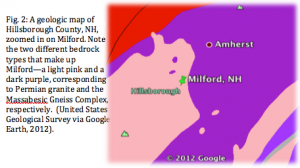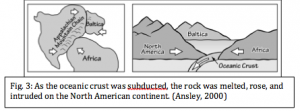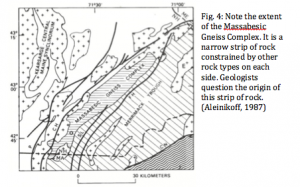A Brief Geologic History of Milford, New Hampshire
By Nakita VanBiene
Growing up in the small town of Milford, New Hampshire, would have been quite boring if I didn’t have a car. Even the largest attraction Milford has, the town drive-in theatre, obviously required a car. But when the drive-in theatre was closed or showing terrible films, which it often was, I turned to Routes 101 and 101A. These roads gave bored teens—licensed bored teens, that is—a chance to escape to the larger city of Nashua within a half an hour’s drive. But unbeknownst to most driving to and from Milford are the geologic stories the exit ramps tell.
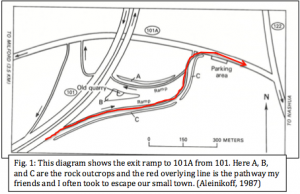
As you drive off of Route 101 to merge onto 101A, you pass between two rock outcrops of significant height (ranging from 3 meters to 15 meters) on either side
(see Figure 1 and Figure 1A). Besides noticing the beautiful icicles that form from water seeping through the rocks during the winter months, I never paid much attention to these outcrops, and drove past like most people would, listening to music or laughing with my friends on the way to the mall.
But now that I’ve been a student at Williams College for almost a year and a half (Williamstown makes Milford feel like Boston), and now that I’ve taken a few geoscience courses, those outcrops seem much more interesting. After some basic geologic research, I discovered
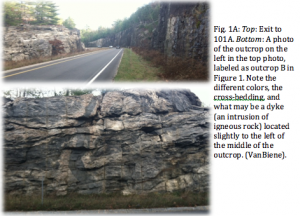
that Milford rests on two different types of bedrock—Permian Granite and the Massabesic Gneiss Complex (see Figure 2). And as it turns out, the outcrops on either side of the exit leading to 101A represent both types, consisting of Massabesic Gneiss with intrusions of Permian Granite (Aleinikoff, 1987). An intrusion, or pluton, forms when hot molten rock rises from the mantle of the Earth and ‘intrudes’ on the crust. This hot magma then cools, forming igneous rocks like granite. The granite in Milford is named after the Permian geologic period, from about 299 million years ago to 251 million years ago, because that is when it formed. A plausible cause for the granite’s formation is continental accretion, more specifically the collision of modern day Africa with modern day North America during the Permian (Kullerud, 2003).
Before the African continent collided with the North American continent, however, the ocean separating the two had to close, meaning that oceanic crust (which lies lower than continental crust) was forced underneath North America. As the plate was pushed, or subducted, underneath the North American continent, the heat from the earth’s mantle melted the oceanic crust, lowering the density of the rock and causing it to rise (Figure 3). This probably caused the intrusion of the Permian Granite (an example can be seen in Figure 1A). This granite has historically been important to the average Milford townsperson, as granite quarries are found sporadically throughout the town (Figure 1 shows an abandoned quarry).
But for a geologist, the Massabesic Gneiss Complex (MGC) is much more interesting. It is much older than the Permian Granite, and has been dated back to about 625 million years old (Dorais, 2001). Because of the pressure of the collision between the North American and African continents in the Permian, the rock already on the continents, like the MGC, changed. Under high temperatures or, in this case, high pressures, rock is altered. Thus the collision of the two continents created high pressures that altered, or metamorphosed, the Massabesic Gneiss Complex. While the cause of metamorphism is somewhat clear, why a rock dating back 625 million years is sitting in New Hampshire amongst Permian aged granite remains a mystery. The complex appears in a very small area of Hillsborough County and its tectonic origins (where the rock actually came from) remain debatable (see Figure 4) (Aleinikoff, 1987). One theory suggests the MGC was exposed as a result of the crust bending under pressure from both sides, lifting the MGC up and exposing the rock to the surface. This process creates a structure known as an anticlinorium. Perhaps as the African continent collided with North America in the Permian, the immense pressure forced the crust to bend and pushed the MGC (of Late Proterozoic age) up.
Another theory, proposed by Michael Dorais et al, suggests the MGC is one of three exposures of the Avalon terrane a significant distance from the coast in New England (Dorais, 2001). An exotic terrane is a micro-continent that accretes to a larger continental land mass. Avalon, originally from the African continental landmass, collided with North America at some point within the Devonian to the Ordovician geologic time periods (from about 360 million years ago to about 500 million years ago), before Africa itself collided with North America.
But while the origins of the MGC remain unclear, one thing is certain: despite Milford’s lack of amusing things to do on a Saturday night, my small hometown is actually geologically intriguing. Now when I drive in between the rock outcrops on the way to Nashua and try to examine the evidence of continental collisions while driving at 40 miles per hour, I have to be careful not to get into a collision of my own.
Works Cited
Aleinikoff, J. N. (1987). The Massabesic Gneiss Complex and Permian granite near Milford, south-central New Hampshire. (D. C. Roy, Ed.) Northeastern Section of the Geolocial Society of America: Centennial Field Guide , 5, pp. 269-72.
Ansley, J. E. (2000). Geologic History. The Teacher-Friendly Guide to the Geology of the Northeastern U.S. (24) , 3-25. The Paleontological Research Institution.
Dorais, M. J. (2001, September). The Massabesic Gneiss Complex, New Hampshire: A Study of a Portion of the Avalon Terrane. American Journal of Science , 301, pp. 657-682.
Kullerud, K. (2003, August 1). Mountain Building. Retrieved November 28, 2012, from WebGeology: http://ansatte.uit.no/kare.kullerud/webgeology// webgeology_files/ english/mountains.swf
United States Geological Survey. (2012, October). New Hampshire geologic map data. (U. D. Interior, Producer) Retrieved November 2012, from USGS Web site via Google Earth

